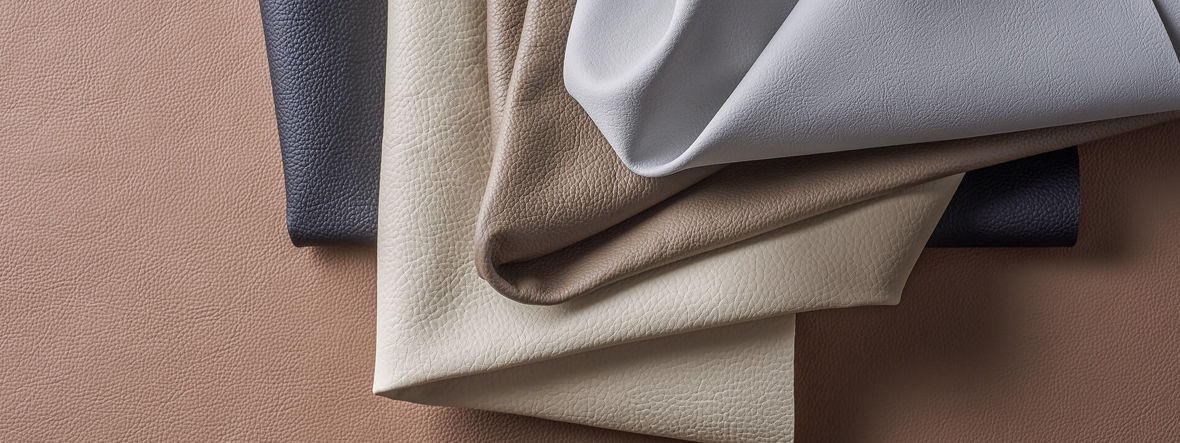Even experts can hardly distinguish artificial leather from the real thing at first glance. The look, structure, and feel of this product now comes very close to its natural model. As a result, artificial leather has become an integral part of our daily lives. It can be found in sofas and dentist’s chairs, luxury handbags and car seats, shoes and clothing. And sometimes it’s even better than the original— in surfaces that are exposed to intense mechanical stress, ultraviolet light or saltwater, or in medical equipment that needs to be frequently disinfected.
High-quality material rather than a cheap imitation: The image of artificial leather is changing. It’s also benefiting from people’s heightened environmental awareness. Processors and consumers are increasingly attaching importance to production methods that harm neither people nor the environment—an expectation that is seldom fulfilled by genuine leather. “Vegan” leather is also popular with shoppers who reject animal products in general.
This has resulted in the steadily growing use of imitation leather. In 2016 the annual worldwide production of artificial leather amounted to about 3.5 million tons. If all of it were to be rolled out in a single piece, it would cover an area equal to the German federal states of Berlin, Hamburg, and Saarland. Asia is the Number One producer of artificial leather, with 85 percent of the annual tonnage coming from China.

A multilayered composite
Artificial leather is a multilayered composite material. It consists of a textile carrier covered with a layer of porous polymer—a type of foam that determines the thickness, feel, and durability of the material. The polymer layer is covered by a wafer-thin topcoat, which is responsible for the product’s color and surface characteristics. In about two thirds of the artificial leather manufactured world wide —or approximately 2.4 million tons— the porous layer consists of polyurethane (PU). Compared to the alternative material PVC, PU feels softer, offers a wider spectrum of characteristics, is lighter and more breathable, and regulates heat more effectively. For Evonik, which is the market leader for PU additives, the artificial leather market is thus an attractive sector.
More than 95 percent of the annual tonnage of PU additives is produced with the help of DMF coagulation. In this process, PU and the organic solvent DMF (dimethylformamide) are used to produce a paste that is spread onto the textile carrier. The PU content of the paste often amounts to 30 percent. The layered textile is soaked in a series of baths consisting of a mixture of water and DMF that wash the solvent out of the paste. During this process, the PU coagulates to create a firm porous layer. The material is then washed once again in order to remove the last DMF residue, dried, and covered with a topcoat. In 2014, more than 550,000 tons of DMF were used for the production of imitation leather in China. It is estimated that by 2019 that figure may increase to 660,000 tons per year.



A technological change has begun
However, DMF is not a good choice for human beings and the environment. According to the European Chemicals Regulation REACH, this solvent is a substance of very high concern and is classified as toxic for reproduction. DMF also presents risks because it is often not sufficiently recycled in artificial leather factories and thus can enter the environment. In addition, residues of this solvent remain in the end product in spite of repeated washing. And finally, the standard manufacturing process consumes large amounts of water and energy.
These negative side effects have motivated a shift to a different technology. The Chinese government aims to reduce the use of DMF by 30 percent by 2020. Pressure is also coming from the artificial leather processing industry, which is increasingly demanding DMFfree materials. Moreover, international initiatives are calling for a ban on hazardous chemicals in textiles or a further reduction of the permissible limit values for DMF in finished products.
This pressure to reduce the use of DMF is opening up corresponding space for environmentally friendly non-toxic alternatives—also in countries other than the main producer, China. Water-based production processes in particular, which have so far represented a niche market, could experience an upswing. According to some forecasts, water-based processes could take over at least 20 percent of the artificial leather market in the coming four to five years.
»The additive optimizes the pore structure of the polymer and lends the artificial leather the desired high quality«
MICHAEL KLOSTERMAN
More environmentally friendly alternatives
From Evonik’s perspective, the PUD process is especially interesting. It begins with the manufacture of an aqueous PU dispersion (PUD) with an approximately 50 percent proportion of polymer microparticles. The dispersion is foamed, and the foam mass is then spread onto the carrier at room temperature. The material is then dried within a few minutes at a temperature of 100°C, covered with the topcoat, and finished.
But so far this alternative, which is much more environmentally friendly, has only played a subordinate role in the market. One of the reasons for that is the inadequacy of the necessary process additives—surfactants and foam stabilizers—which are added to the production process in only small amounts but play a key role in determining the quality of the final product. The additives that are used most often today react sensitively to hard water, are incompatible with certain crosslinking agents, and migrate to the surface of the material, where they form unsightly spots or an unpleasant greasy film. In addition, the surfactants that have been used to date often result in very course foam structures and do not sufficiently stabilize this foam during the production process.
These are the issues that were addressed by the researchers at Evonik. They have now developed an additive that does not have any of these negative side effects, but instead offers additional advantages. “It optimizes the pore structure of the polymer, accelerates the production process, conserves energy, and lends the artificial leather the desired high quality,” explains Dr. Michael Klostermann, who is responsible for the technical product development of the new additive.


Fine and uniform pores
The new additive, which is being marketed as ORTEGOL® P 1, is an organic non-ionic surfactant—a product group about which Evonik possesses extensive know-how. Among other things, organic non-ionic surfactants are used as highly effective emulsifiers for skin creams and lotions. Emulsifiers have functions that are very similar to those of surfactants: They disperse materials and stabilize one phase in another. This results in large surface areas that play a key role in determining the characteristics of the end product. Through ORTEGOL® P 1, Evonik has now made the way in which these surfactants work usable for the production of artificial leather too.
The new additive is added to the PUD dispersion before the foaming process in quantities of just a few percent of the total mass. The function of the additive is to keep the foamed dispersion on the carrier stable until it has completely dried into a foam. That’s the only way to create the fine and uniform pores that make artificial leather soft, smooth, and supple. Tests carried out in cooperation with artificial leather manufacturers have shown that ORTEGOL® P 1 is equal to this task. It stabilizes not only the individual air bubbles but also the continuous phase of the aqueous foam.


More environmentally friendly alternatives
From Evonik’s perspective, the PUD process is especially interesting. It begins with the manufacture of an aqueous PU dispersion (PUD) with an approximately 50 percent proportion of polymer microparticles. The dispersion is foamed, and the foam mass is then spread onto the carrier at room temperature. The material is then dried within a few minutes at a temperature of 100°C, covered with the topcoat, and finished.
But so far this alternative, which is much more environmentally friendly, has only played a subordinate role in the market. One of the reasons for that is the inadequacy of the necessary process additives—surfactants and foam stabilizers—which are added to the production process in only small amounts but play a key role in determining the quality of the final product. The additives that are used most often today react sensitively to hard water, are incompatible with certain crosslinking agents, and migrate to the surface of the material, where they form unsightly spots or an unpleasant greasy film. In addition, the surfactants that have been used to date often result in very course foam structures and do not sufficiently stabilize this foam during the production process.
These are the issues that were addressed by the researchers at Evonik. They have now developed an additive that does not have any of these negative side effects, but instead offers additional advantages. “It optimizes the pore structure of the polymer, accelerates the production process, conserves energy, and lends the artificial leather the desired high quality,” explains Dr. Michael Klostermann, who is responsible for the technical product development of the new additive.

Energy use is reduced by 50 percent
“The additive can do even more. During the production of artificial leather, it significantly improves the balance of energy, raw materials, and emissions,” says Dr. Kai-Oliver Feldmann, who is responsible for coordinating the contacts between product development and technical customer support. Compared with the DMF coagulation process, the new procedure saves producers about half of their energy consumption and also drastically reduces emissions. The new additive is based on renewable raw materials, and that’s a further advantage by comparison with DMF.
ORTEGOL® P 1 has been produced in Duisburg since the end of 2017 and is already being used by the first group of customers in Germany and China. And P1 is only the beginning. Evonik is currently working to develop additional types of ORTEGOL® P that enable customers to precisely adjust the pore size, density, and flow properties of the foam and thus determine the performance of their artificial leather. The aim is to ensure that the ORTEGOL® P family can cover the entire spectrum of applications in the artificial leather market.
Evonik is launching the new additive on the market at a time when the artificial leather industry is changing and searching for alternatives. ORTEGOL® P 1 is the first successfully tested candidate from a group of surfactants that make water-based processes practicable and environmentally friendly. As a result, Evonik is successfully addressing the requirements of manufacturers and consumers who set great store by high-quality artificial leather and also expect that its production will not harm people and the environment.
GLOSSAR
Dimethylformamid (DMF) is an organic solvent that is often used in the production of polymers such as polyurethane
DMF coagulation is a process of layering in which a paste made of polyurethane resin and DMF is spread onto a textile carrier and the DMF is then washed out in a series of baths. The polyurethane continues to adhere to the textile and hardens there
Polyurethanes (PU) are versatile plastics or artificial resins. Today they are used in the production of high-quality artificial leather, among
PVC (Polyvinyl chloride) is one of the most important polymers for the production of plastics. Since the 1940s it has also been used to produce artificial leather


